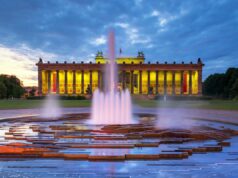If you want to travel to Germany, it is important you know as much as possible about the country itself, isn’t it? Germany is not one big country, but separated into different German states. You will get more information about these states in the following article.
The 16 German states
Germany consists of 16 different states, with each state having its own flair. The German states mostly differ in dialects, size, as well as landscapes and economy. Here is a list of all 16 German states:
- Baden-Württemberg
- Bavaria
- Berlin
- Brandenburg
- Bremen
- Hamburg
- Hesse
- Mecklenburg-Vorpommern
- Lower Saxony
- North Rhine-Westphalia
- Rhineland-Palatinate
- Saarland
- Saxony-Anhalt
- Saxony
- Schleswig-Holstein
- Thuringia
Baden-Württemberg
Baden-Württemberg’s capital is Stuttgart. The people in this state are proud of their industry and known to be hard-working to maintain how well it is running. The dialect that is spoken there is said to be difficult to understand, but this does not change the fact that Baden-Württemberg is a beautiful state.
If you are interested in visiting Baden-Württemberg, you will benefit from the beautiful old cities and lakes. Especially Heidelberg is a must-see, since it is home to the oldest university in Germany, and a beautiful city in general.
Bavaria
As the largest state in Germany, Bavaria is known for its industry. Many big companies are based in Bavaria. Bavaria’s capital is Munich.
Something people always notice about Bavarians is their love for their traditions. The best example of the way they exert these traditions is the Oktoberfest that takes place every year. People from all around the world travel to Munich to witness Lederhosen and Dirndl or listen to the popular Volksmusik.
Bavaria has a lot of different things to offer. While the Oktoberfest is probably the most popular one, the state has beautiful castles – specifically Neuschwanstein – and romantic cities to offer.
Berlin
Yes – Berlin is both the capital and the largest city of Germany, and one of the 16 German states. Berlin is the place of many new businesses; many businesses are opened here, and the industry is thriving.
Besides that, Berlin has a lot to offer. Different museums and galleries, the Brandenburger Tor, the famous zoo – these are just a few things that make Berlin a must-see.
Brandenburg
Brandenburg is close to Berlin and its capital is Potsdam. The state is perfect for people who want to be surrounded by lots of nature and recharge. Since Brandenburg is part of the UNESCO world heritage, it has biospheres and different nature parks to offer. This is all because of the low population density of the state, making it possible for nature to thrive.
Bremen
Bremen is the second city state of Germany. It is mostly known for its status as one of the Free Hanseatic Cities and essential for trading.
Bremen scores with beautiful old town vibes and its impressive statues.
Hamburg
Hamburg is one of the three city states and Free Hanseatic Cities of Germany. It is mostly known for its large port and hence attracts many visitors. The Reeperbahn and the old warehouse district are a must-see.
Hesse
Hesse is home to the airport in Frankfurt, one of the most important airports in the world. Its capital, however, is Wiesbaden.
Hesse has a very good economy and profits from the status that Frankfurt has acquired. Nonetheless, it is also known for its many wooded houses and different structures. Cities like Frankfurt and Kassel have an oldish flair, if you know where to look. Kassel was also the hometown of the Brothers Grimm.
Mecklenburg-Vorpommern
The capital of Mecklenburg-Vorpommern is Schwerin. Mecklenburg-Vorpommern is probably most popular because of its islands and different seaside resorts. Visitors can relax and benefit from the beautiful nature and seasides.
Lower Saxony
Lower Saxony’s capital is Hanover. As the second-largest state, Lower Saxony welcomes many tourists per year. Visitors are attracted by the many old cities, such as Goslar and Braunschweig, and their histories.
North-Rhine Westphalia
The capital of North-Rhine Westphalia is Düsseldorf. As a state, it has many different things to offer. Visitors can check out the beautiful Rhine-Ruhr region or spend their holidays in the Eifel mountains, go shopping or cycling.
Rhineland-Palatinate
Rhineland-Palatinate is especially known for its wine, beer and chemistry industry. Its capital is Mainz. However, visitors not only benefit from the rich wine and beer industry, but can also visit beautiful castles or villages. Besides, Rhineland-Palatinate’s Rhine Gorge and the city of Trier are part of the UNESCO World Heritage.
Saarland
Saarland’s capital is Saarbrücken. Though it is the smallest German state, it has a lot of history. In the past, it was part of France, which is why many people still speak French there.
A must-see is the old town of Saarbrücken. Visitors can benefit from the wide range of museums and galleries, too.
Saxony-Anhalt
The capital of Saxony-Anhalt is Magdeburg. The state profits from its thriving chemical and food industry. Known for its Baumkuchen, Saxony-Anhalt is the place in many different sagas and legends. Hence, there are a lot of places you can visit. Especially the Martin Luther memorial places are nice to visit.
Saxony
Saxony’s capital is Dresden. Saxony is best known for its electronics and microsystems industries. Visitors can stroll around and admire baroque architecture.
Schleswig-Holstein
The capital of Schleswig-Holstein is Kiel. The state is surrounded by two different seas. Consequently, it attracts many visitors because of the possibility of surfing and sailing. Apart from that, Lübeck and Kiel are two of the most beautiful cities to visit in Schleswig-Holstein.
Thuringia
Thuringia with is capital Erfurt is the state of famous people. Famous people like Goethe, Schiller or Bach lived there. If you want to get a feeling of the history of Germany and huge parts of its culture, Thuringia is the right place to visit.
German states are very diverse
In the end, it is really difficult to say which one of the German states is the most beautiful or has the most to offer. It is all about preference and what you are generally looking for. If you want to stay close to the sea, Schleswig-Holstein is a must. On the other hand, states like Rhineland-Palatinate and Brandenburg are famous because they are part of the UNESCO World Heritage.
FAQ – German states
The 16 German states are Baden-Württemberg, Bavaria, Berlin, Brandenburg
Bremen, Hesse, Mecklenburg-Vorpommern, Lower Saxony, North Rhine-Westphalia, Rhineland-Palatinate, Saarland, Saxony-Anhalt, Saxony, Schleswig-Holstein and Thuringia.
The two largest German states are Bavaria and Lower Saxony.
Both Rhineland-Palatinate and Brandenburg are part of the UNESCO World Heritage.















